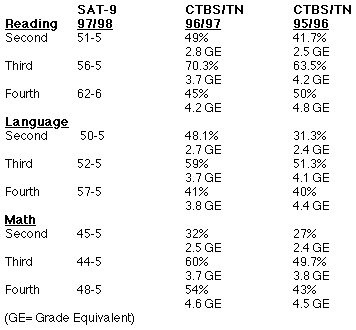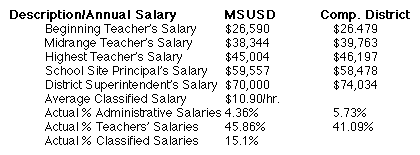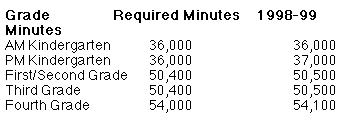Links Within This Site
Superintendent's Page
Mt. Shasta Elementary School
Sisson School
Classroom Web Pages
Challenge Home School
Return to MSUSD Homepage
Other Links
Siskiyou County Schools
Mt. Shasta Elementary School
A
Proud Tradition of Education since 1897
School Report Card · Spring 1999
Mila Livie-Spengler, Principal
501
Cedar St.
Mt. Shasta, CA 96067
(530) 926-3434 · FAX 926-2827
Message from the Principal....
Mt. Shasta Elementary, located 40 miles south of the Oregon border at the base of its 14,127 ft. namesake, houses a K-4 grade school of 405 students. Twenty fully credentialed classroom teachers and three credentialed specialists are all working within their subject areas to provide quality education to all of our children. Each classroom is supported by a 90-120 minute teaching assistant and quality support staff to maintain supervision and facilities.
Class size K-3 averages 20 with no class exceeding 20 students due to Class Size Reduction Funding. Our fourth grade classes average 23.
In our efforts to provide strong curriculum and effective teaching strategies, we maintain a 90 minute uninterrupted Language Arts block daily. Our bookroom provides leveled reading materials and thematic units for use in the classroom. We have focused monies from several sources to improve and enlarge our Library and Bookroom collections. The Mt. Shasta Educational Foundation, Reading Improvement Grant, Library Grants and One Time Site dollars have all helped fund this effort. The Accelerated Reading Program has recently been added to our school to increase interest in reading opportunities.
We are in the process of reevaluating our math program and the instructional texts. We are seeking texts that represent the state's math standards in a "balanced program".
Each classroom has internet access and is equipped with at least one Power Mac computer. We have a small bank of six computers located in the library for student research and use.
Cable television connections have been added to each room this year through a business partnership with Northland Cable Co. providing all the wiring and service, allowing teachers to access educational programming for their students.
The Mt. Shasta area offers many natural resources that can be incorporated into our outdoor science programs, including the Salmon and Trout Projects, raising anadromous fish for release into local streams, Adopt-a-Watershed, riparian projects and the Castle Lake Project studies of aquatic and botanical life indigenous to the area. Our Life Lab garden and grow labs provide hands on science projects for full school use. Parents and community volunteers are an integral part of these programs.
A bond passed in May of 1997 will provide two classrooms and a larger multipurpose room facility to support the performance arts.
Mt. Shasta Elementary school has a high level of parent and community support, reflected in our classroom volunteers. Our staff, parents and community members are united in their efforts to help students reach their potential to become responsible adults and succeed as a productive member of an ever changing society.
School Facilities Safety
Mt. Shasta Elementary School is a beautifully maintained older school, originally built in 1941. The north wing was added in about 1946 and the building has undergone several upgrades, including one in 1987. Nine portable classrooms and a multipurpose room have provided additional space. In 1996, the building was completely wired with internet access for each classroom. This fall we were equipped for cable access in each room. In May, 1997, we passed a bond that will add another multipurpose room, kitchen, two additional classrooms and retrofit our library.
The school grounds and buildings are well-maintained
by the maintenance and housekeeping staff and are inspected monthly
by the maintenance staff and annually by the liability carrier.
We have a safety committee that meets regularly to identify any
areas of concern. Any items sited are promptly addressed and
corrected. Repairs and renovations are ongoing.
Student Assessment and Achievement
 |
In September of 1997, Mt. Shasta Elementary became a participant in the California Reading and Literature RESULTS Project for assessment of specific reading skills for students. Each student K-3 is individually assessed and that information is then collected and evaluated along with the 1500 students statewide to provide benchmarks in learning and development. This tool is being used diagnostically to improve individual instruction to students K-4.
In March,1998 and 1999, we participated in Stanford-9 Assessment for the State's STAR Program. The 1998 results are provided. The 98/99 SAT-9 results will be posted on the internet after June 30. These scores should closely coordinate with the 97-98 scores.
The test results allow us to compare our students with others in the same grade level throughout the state and will provide longitudinal information for the site/district.
There is some variation on the reporting format from the prior two years where the CTBS and Terra Nova Tests were used. For the SAT-9 Report, the first two digits given are the percentile ranking as compared to the national norms. This number will basically correlate to the percentile of previous years. (ie. 50 - 5)
The second number after the dash (hyphen) is the stanine score (ie. 50-5). This generally breaks down into three levels on a scale of 1-9. Stanines of 1,2,3 indicate below grade level performances, 4,5,6 indicate performance at grade level and 7,8,9 are above grade level indicators. No grade equivalents are provided.
In 1997-98, the second, third and fourth grades all tested at the 5th stanine, mid range or above, in reading, language and math. As the graphs indicate, MSE scored at or above county and state averages in all areas: reading, math, language and spelling.
Enrollment Pattern
Over the four previous years MSUSD has been experiencing a declining enrollment. This year, however, enrollment has steadied and regained some of the loss. Following a study to trace the movement we have found that a majority of the families have moved out of the area or the state.
 |
Staff
Mt. Shasta Elementary has 20 full-time classroom teachers and 3 specialists, fully certificated and working in their credentialed area. We contract for nursing, counseling, speech and language and psychologist services. Each classroom has a ninety-minute to two hour teaching assistant.
We have one maintenance person and three housekeeping staff to manage and maintain the site. In addition to the principal, the office staff includes 1.25 secretaries. We also have varying percentages of a Library Media Specialist, Quiet Room supervisor, duty personnel, Day Care Coordinator and Breakfast Coordinator.
 |
Substitute Teachers
At MSES, we have a sufficient number of qualified substitutes to cover teacher absences. Teachers were absent 3.3% of the time. These absences include conferences, illnesses, personal leaves and jury duty. Substitutes report to the office. They are provided with lesson plans prepared by the teacher and pertinent school information.
Professional Growth
The school and staff recognize the importance of and are committed to ongoing professional growth opportunities for all staff members, certificated and classified. This training allows the staff to remain current in educational research and application strategies.
In August of 1998, a two day inservice was held on Spelling and Word Study by Donald Bear, author of Words Their Way.
Attendance
Regular, on time attendance is directly related to the academic success of each student. The classroom and many enriching experiences cannot be duplicated when a student is absent.
Regular attendance is reinforced by parent phone calls, individual student contracts, letters home and parent/student conferences.
In 1997 to 1998, the attendance rate at MSES averaged: Kindergarten 99.61% and Grades 1-4 99.65% .
Support Services
Our Early Intervention Program Coordinator organizes the efforts of our support programs, assessing and determining need, and identifying services available to maximize effectiveness. Support services and Categorical programs provided for students include: Title 1, Miller Unruh, School Site Council, Counseling, Quiet Room/Intervention, School Nurse, School Advisory Council, Speech and Language Specialist, Resource Specialists/Inclusion, Subsidized Meal, Program, Student Study Team, and GATE.
Mt. Shasta Union School District Special Funding
Special funding sources are given to specific programs. They include:
 |
Ethnicity
According to the most current CBEDS Report of October 1998, the ethnic representation of our district is as follows:
 |
Cost of Education
The average cost of educating a child in the Mt. Shasta Union School District is $5,451.77 per student. This figure includes the expense of all salaries, classroom supplies, special support programs, maintenance, grounds keeping, furniture and equipment, utilities and transportation.
School Climate
At Mt. Shasta Elementary School we strive to provide a calm, respectful, supportive environment for learning. We work as a team to provide consistency in the classroom and on the playground. We believe that a healthy school climate promotes academic success.
The classroom is our primary focus for discipline. Each teacher provides a well defined discipline policy for their students through classroom management. We provide positive discipline through praise and recognition. Keeping class sizes low has allowed teachers more individual time with students and lowered student referrals. Direct communication with parents has been an effective method of addressing negative behavior.
Student office referrals and suspensions have decreased dramatically over the last three years coinciding with class size reduction. When students are referred to the office the principal talks to the students and helps students define appropriate behaviors to avoid future occurrences. Consequences include: phone calls to parents, time in the Quiet Room, community service, time spent with the principal or suspension, when indicated. We have a very low incidence of fights or violent behavior.
Curriculum and Instruction
Curriculum and assessment are coordinated through collaborative efforts. As a staff, we have worked to create consistency of a balanced reading program. We assess each student K-4 three times per year through RESULTS assessment, a diagnostic reading pilot program through the California Reading and Literature Project. This allows us to identify students' needs and target those areas, as well as contribute data to the state reading project.
Following the guidelines for textbook adoption provided by the State Department of Education, we have teachers at each grade level examine and evaluate new adoption materials. We adopted the Mathland series for math in 1995-96. We have a partial adoption of the Scholastic reading materials, supplemented with the guided, leveled reading books located in the new Book Room. In Science, we are using Merrill Accents, and Houghton Mifflin in the area of Social Science.
This year we selected math and spelling as a focus for discussion and evaluation. We are in the process of redefining the components of a balanced math program. This process will help us coordinate and articulate math K-4.
Instructional Minutes
By state requirement, students are to be provided
a minimum number of instructional minutes over a period of 180
days each school year.
 |
Return to Mt. Shasta Elementary School...
All text on this page by Sherry Zandona.